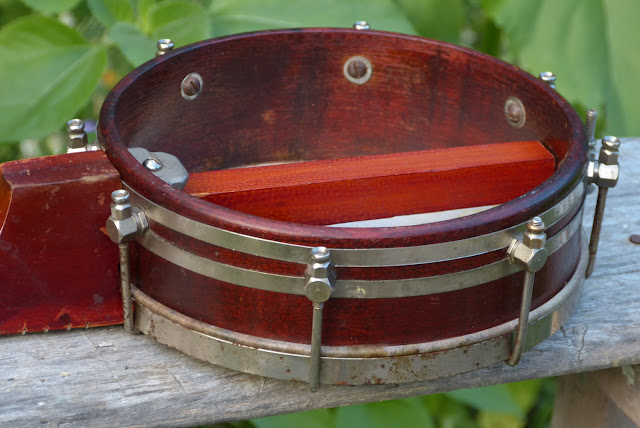1920s Oscar Schmidt "Stella" Banjo Uke
I've worked on far too many of this same, basic, New Jersey-made, Oscar Schmidt banjo-uke model. I buy them to fix and sell because every time I have them in, folks love them (me, too). There's a reason: they have a distinctly woody, warm, "old-timey" sound that's in direct contrast to a lot of period banjo-ukes which can be brash, bright, and zingy (and need much muting for taming purposes). They're easy on the ears in almost any player's hands and they're also closer to the weight of a regular soprano uke.
This one came to me in good overall shape, though the frets were wonky-enough to warrant a refret (which I did with mandolin-sized wire). I also gave it a general setup, replaced one missing hook/nut, added side dots, a replacement bridge, and cleaned it up. It's playing right on target with 1/16" action at the 12th fret and has an easy, quick feel.
By now, after seeing dozens of these, the worn-in original head (blue mark appears to be an old stamp?) and worn-in red-brown finish is all-too-familiar.
I forgot that I also replaced a damage nut with an ebony one. The tuners are period but don't appear to be original. They were on it when it came in and I added extra washers all-around to get them to turn and hold smoothly.
This uke has a 13 1/4" soprano scale length and a wider, more "Hawaiian-ish" string spacing at the bridge. The neck profile is a medium C shape which makes closed-position sliding chords a little easier as there's more to brace your wrist/thumb against when moving up and down the neck.
The strings are my standard fluorocarbon set and are comparable to a Martin M600 set.
I recut an old Grover bridge to all-maple and slotted it to follow the spacing defined by the fretboard.
It's a cute uke! I'm pretty sure the wood is mostly poplar.
The neck brace is particularly effective -- one knocks it into place and then uses the set screw to keep it snug.
My foam pad shoved against the back of the head is an overtone-ring mute and slight dampener. It cleans-up the tone in general (very useful for a lot of chording), but isn't at all necessary. The uke can be quite loud, too, with it removed -- even though it's plenty-loud with it on.
It's nice to have the original tailpiece, too -- this is the part that most-often goes missing.
















Comments